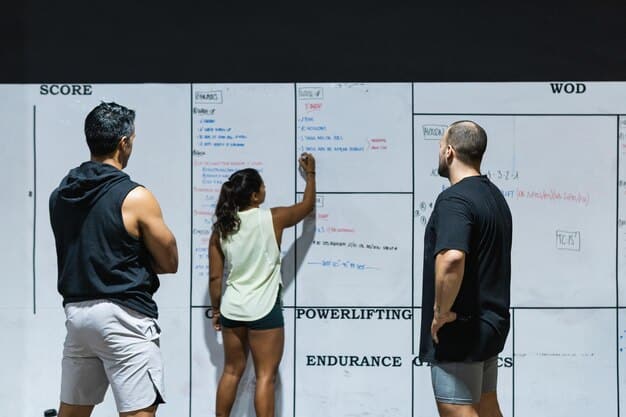King’s League USA: How Player Injuries Impact Team Standings

Injuries to key players in King’s League USA significantly impact team standings by affecting team dynamics, strategy execution, and overall performance, leading to unpredictable shifts in the league’s competitive landscape.
The King’s League USA is known for its thrilling matches and star-studded lineups. However, the unpredictable nature of sports means that injuries can play a pivotal role in shaping team performance. This article explores how injuries to key players in **King’s League USA: How Injuries to Key Players Have Affected Team Standings**, and how these setbacks influence their position in the league.
Understanding the King’s League USA
The King’s League USA has quickly become a prominent name in the world of soccer, drawing significant attention with its unique format and celebrity involvement. Before diving into the impact of injuries, it’s essential to understand what sets this league apart and why the fitness of its players is so crucial.
What Makes the King’s League USA Unique?
Unlike traditional soccer leagues, the King’s League USA features innovative rules and gameplay that create a more entertaining and dynamic viewing experience. This includes elements like shorter match durations, penalty shootouts mid-game, and special cards that introduce unexpected twists.
- Celebrity Involvement: Team owners include well-known figures from sports, music, and entertainment, bringing a broader audience to the league.
- Innovative Rules: The league’s unique ruleset adds excitement and unpredictability to each match.
- Fan Engagement: King’s League USA emphasizes fan interaction, allowing viewers to influence certain aspects of the game.
These elements combine to create a high-octane environment where every player’s contribution is magnified, making the impact of injuries even more significant.
Understanding the unique elements of the King’s League provides context for why player injuries can drastically alter team dynamics and standings. The league’s emphasis on individual contributions and unpredictable gameplay means that even a single injury can have far-reaching consequences.

The Ripple Effect of Key Player Injuries
When a star player is sidelined due to injury, the effects can be felt throughout the entire team. It’s not just about the loss of that player’s individual skills; it also affects team morale, tactical flexibility, and overall strategy.
Immediate Impact on Team Dynamics
The absence of a key player can disrupt established partnerships and create gaps in the team’s formation. Other players may need to adjust their roles, leading to unfamiliar responsibilities and potential communication breakdowns.
Injuries force coaches to make difficult decisions about replacements and tactical adjustments. It tests the depth of the squad and the adaptability of the remaining players.
Long-Term Strategic Consequences
Beyond the immediate game, injuries can have lasting effects on a team’s strategic planning and overall season goals. It can force a team to reassess its strengths and weaknesses, potentially leading to significant changes in tactics or player acquisitions.
- Altered Tactics: Teams may need to adopt a more defensive or counter-attacking style to compensate for the loss of offensive firepower.
- Player Development: Injuries can provide opportunities for younger or less experienced players to step up and prove their worth, potentially uncovering new talent.
- Psychological Impact: A string of injuries can negatively affect team morale and create a sense of instability, impacting performance in future matches.
The ripple effect of key player injuries can extend far beyond a single game, influencing a team’s strategic direction and psychological resilience. Teams that can effectively manage these challenges are more likely to maintain their competitive edge and achieve their season objectives.
Analyzing Specific Cases of Injury Impact
To truly understand the extent of the impact, it’s helpful to look at specific examples of teams in King’s League USA that have experienced significant setbacks due to player injuries and how they navigated these challenges.
Case Study 1: Club A – The Midfield Maestro
Club A started the season strong, largely due to their star midfielder, whose playmaking abilities controlled the tempo of every game. An abrupt knee injury took him out indefinitely, leaving a palpable void in the midfield.
The team struggled to find a replacement who could replicate his vision and passing range. Their reliance on his creative input meant that their offensive plays became predictable.
Case Study 2: Team B – The Defensive Stalwart
Team B built their success on a rock-solid defense, anchored by their experienced center-back. When he suffered a hamstring injury, the team’s defensive stability was immediately compromised.

Opponents began exploiting the gaps in their defense, resulting in several high-scoring losses. The team was forced to re-evaluate their defensive strategy and bring in reinforcements.
These case studies illustrate how injuries to key players, whether in midfield or defense, can expose vulnerabilities and force teams to adapt quickly. The ability to adjust tactics and find suitable replacements often determines whether a team can remain competitive or experience a significant drop in performance.
Strategies for Managing Injury Crises
While injuries are an inevitable part of sports, teams can implement strategies to mitigate their impact and maintain a competitive edge. These strategies range from preventive measures to tactical adaptations.
Preventive Measures and Training Techniques
Prevention is always better than cure. Implementing robust training programs that focus on injury prevention can significantly reduce the risk of player setbacks.
- Strength and Conditioning: Targeted exercises can strengthen muscles and joints, reducing the likelihood of strains and sprains.
- Proper Warm-Up and Cool-Down: Adequate preparation and recovery routines can help prevent muscle stiffness and injuries.
- Load Management: Monitoring player workload and adjusting training intensity can prevent overuse injuries.
Investing in injury prevention is a proactive approach that can keep key players on the field and minimize disruptions to team performance.
Tactical Adaptations and Roster Depth
Having a versatile squad with players who can fill multiple roles is crucial for navigating injury crises. Tactical flexibility allows coaches to adjust formations and strategies without compromising the team’s overall effectiveness.
Teams can adapt by promoting young talents who can step up and fill the void, or by adapting their usual tactics to accommodate the new player(s).
Effective crisis management involves a combination of prevention, tactical flexibility, and a deep roster. Teams that prioritize these strategies are better equipped to weather injury storms and sustain their competitive performance.
The Mental Fortitude of Teams
Beyond the physical challenges, injuries can take a significant toll on a team’s mental state. Maintaining psychological resilience is essential for overcoming adversity and staying focused on their goals.
Building a Resilient Team Culture
Creating a supportive and positive team environment can help players cope with the stress and uncertainty caused by injuries. Open communication, mutual support, and a shared sense of purpose can foster resilience.
Resilient teams view setbacks as opportunities for growth and learning, rather than as insurmountable obstacles. This mindset can help them bounce back from adversity and maintain their competitive spirit.
Leadership and Communication During Tough Times
Strong leadership is crucial for guiding a team through challenging periods. Effective communication can help to keep team morale high, ensure the team stays on the same page, and promote the players’ confidence.
The mental fortitude of a team can be just as important as their physical capabilities. Teams that cultivate resilience, foster open communication, and provide strong leadership are better equipped to navigate the psychological challenges of injuries and maintain their focus on achieving their goals.
Predicting Future Impacts and Trends
As sports science and data analytics continue to evolve, teams are gaining a better understanding of injury risks and developing more sophisticated strategies for prevention and management. Predicting future impacts and trends will be crucial for staying ahead of the game.
Advancements in Sports Science and Rehabilitation
New technologies and techniques are revolutionizing the way injuries are diagnosed, treated, and prevented. From advanced imaging to personalized rehabilitation programs, these advancements offer hope for faster recovery times and reduced risk of re-injury.
Sports science is also playing a growing role in optimizing training regimens and monitoring player workload, helping teams to identify potential injury risks before they materialize.
The Role of Data Analytics in Injury Prevention
Data analytics is providing teams with valuable insights into the factors that contribute to injuries. By analyzing player performance metrics, training data, and medical records, teams can identify patterns and trends that might otherwise go unnoticed.
This data-driven approach allows teams to tailor their training programs, manage player workload more effectively, and make informed decisions about player selections.
As sports science and data analytics continue to advance, teams will have access to increasingly sophisticated tools for predicting, preventing, and managing injuries. Those that embrace these innovations will be better positioned to protect their players and maintain their competitive edge.
| Key Point | Brief Description |
|---|---|
| 🤕 Key Player Injuries | Significantly impact team performance and standings. |
| 🔄 Tactical Adaptations | Teams adjust strategies to compensate for missing players. |
| 🧠 Mental Fortitude | Resilience and leadership are crucial during injury crises. |
| 📊 Data Analytics | Helps in predicting and preventing injuries through data analysis. |
Frequently Asked Questions
▼
Injuries often force teams to alter their strategies, potentially shifting focus from offense to defense or relying more on counter-attacks depending on which players are sidelined.
▼
Sports science helps teams design targeted training programs, manage player workloads, and identify potential injury risks early on, reducing the overall number of injuries.
▼
Team morale is critical; a supportive environment, open communication, and strong leadership can help players stay focused and resilient, positively influencing team performance.
▼
Data analytics can identify patterns and trends that indicate a higher risk of injury, enabling teams to take preventive measures and adjust training or tactics as needed.
▼
Common injuries include muscle strains, sprains, knee injuries, and ankle injuries, often resulting from the high-intensity gameplay and unique rules of the league.
Conclusion
In conclusion, injuries to key players in King’s League USA significantly impact team standings. Effective strategies for managing these setbacks include preventive measures, tactical adaptations, and fostering mental fortitude within the team. As sports science and data analytics continue to evolve, teams will become better equipped to minimize the impact of injuries and maintain their competitive edge.





